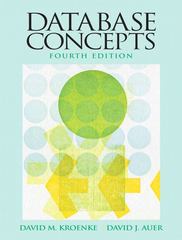Question
QUESTION 1 Which statement is true about the DENY and REVOKE statements? a. Both DENY and REVOKE work exactly the same b. Neither a revoked
QUESTION 1 Which statement is true about the DENY and REVOKE statements? a. Both DENY and REVOKE work exactly the same b. Neither a revoked permission or a denied permission can override a permission granted by role membership c. A denied permission can be granted by role membership, but a revoked permission cannot d. A denied permission cant be granted by role membership, but a revoked permission can
QUESTION 2 You can use the GRANT statement to give users permission to use each of the following items except for one. Which one? a. a DDL statement b. a database object c. all the objects in a database d. all the objects in a schema
QUESTION 3 A user whos granted the REFERENCES object permission can do what? a. create objects that refer to the object b. all of the above c. select but not insert, update, or delete data in the object d. refer to the object in a subquery
QUESTION 4 The entities that can be secured on a server are called ________________. a. securables b. principals c. IDs d. permissions
QUESTION 5 Which of the following statements creates a database user in the current database from a TomBrown SQL Server login ID? a. CREATE DB USER TomBrown; b. USER TomBrown; c. CREATE USER TomBrown; d. EXEC USER TomBrown;
QUESTION 6 To log on to SQL Server using your SQL Server login ID, you use ________________ authentication. a. SQL Server b. mixed c. Windows d. server
QUESTION 7 Which of the following statements creates a SQL Server login ID for a user named TomBrown with the password abc123XYZ. a. CREATE LOGIN TomBrown WITH PASSWORD = 'abc123XYZ'; b. EXEC LOGIN TomBrown WITH PASSWORD = 'abc123XYZ'; c. CREATE LOGIN TomBrown WITH 'abc123XYZ'; d. CREATE TomBrown WITH PASSWORD = 'abc123XYZ';
QUESTION 8 Where would you go to create, modify, or delete logins using the Management Studio? a. the Users folder for the server b. the Security folder for the database c. the Security folder for the server d. the Users folder for the database
QUESTION 9 Which statement can you use to create a user-defined database role? a. CREATE ROLE b. MEMBER ROLE c. SERVER ROLE d. DATABASE ROLE
QUESTION 10 All of the following statements about application roles are true except for one. Which one? a. Once a connection activates an application role, its security profile can only be changed back to that of the login ID if a cookie is created when the role was activated. b. Unlike a standard database role, an application role can contain only one member. c. An application role is activated by executing a stored procedure. d. Once a connection activates the application role, its security profile changes from that of the login ID to that of the application role.
Step by Step Solution
There are 3 Steps involved in it
Step: 1

Get Instant Access to Expert-Tailored Solutions
See step-by-step solutions with expert insights and AI powered tools for academic success
Step: 2

Step: 3

Ace Your Homework with AI
Get the answers you need in no time with our AI-driven, step-by-step assistance
Get Started


